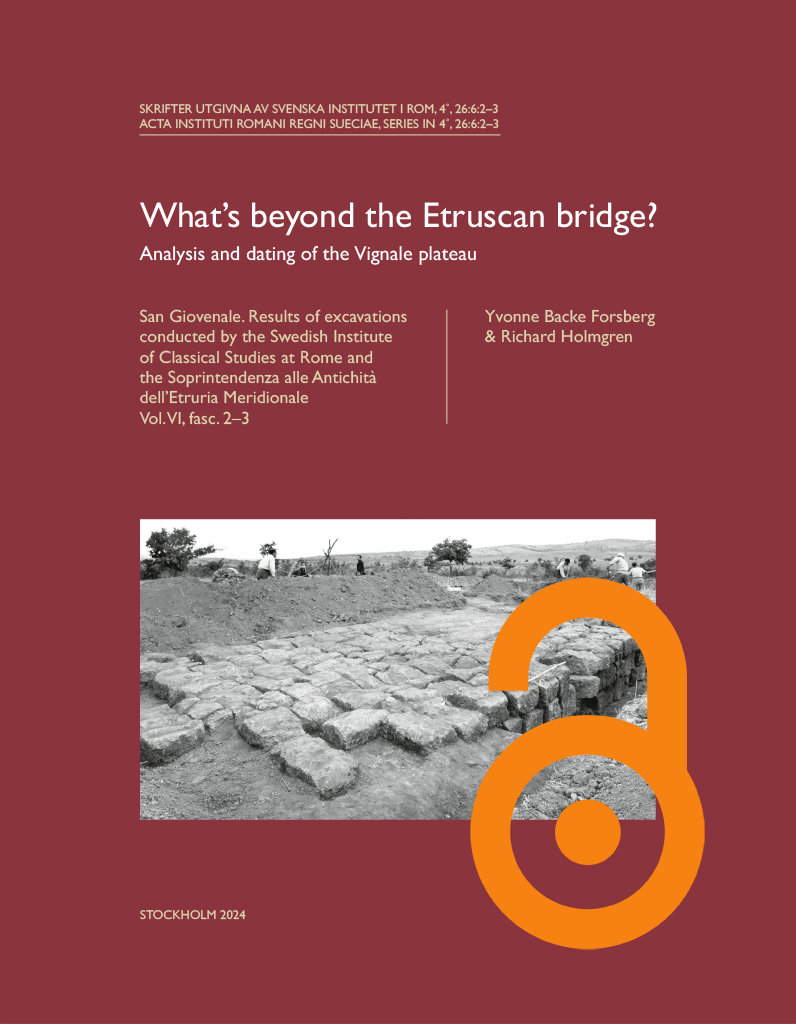San Giovenale vol. 6, fasc. 2–3. What’s beyond the Etruscan bridge? Analysis and dating of the Vignale plateau By Yvonne Backe Forsberg & Richard Holmgren. Stockholm 2024. ISBN: 978-91-7042-188-4 (hardcover: 345 pp.). https://doi.org/10.30549/actarom-4-26-6-2-3 For more information about the San Giovenale-series, see https://ecsi.se/actarom-4-26/ Published by the Swedish Institute of Classical Studies in Rome. Distributed by Eddy.se AB. Open access, use links below. The Etruscan site of San Giovenale has been excavated periodically since 1956. From the beginning the main focus has been the question of settlement remains. However, a fundamental area within the site had still not undergone the inquiry necessary for a complete understanding of the site as a whole. The Vignale plateau, connected to the main site by an Etruscan bridge, was surveyed and partly excavated in 1959–1960, but not published. The Vignale Archaeological Project (VAP) began new investigations in 2006 that aimed to answer the question of “What’s beyond the Etruscan bridge?” This publication focuses on the initial investigations of 1959–1960, augmented by new ground- and aerial remote sensing surveys. The current volume is divided in six chapters. Through an introduction, and geological/topographic and historical/archaeological settings (Chapters 1–3), the reader achieves a general understanding of Vignale within a…
Opuscula 15 is published by the Swedish Institutes at Athens and Rome. Distributed by Eddy.se AB. View volume at ERIH PLUS. Late Etruscan tripod thymiateria By Örjan Wikander Abstract This article is a further development of questions raised in my review of Laura Ambrosini’s magisterial Thymiateria etruschi in bronzo (2002), and it is mainly based upon material gathered by her. Whereas I mostly agree with Ambrosini’s conclusions, the discussion includes some dissent concerning production centres (Chiusi and Tarquinia in particular), chronology (beginning and end-date of production), and the function of the censers. Otherwise, a series of case studies clearly confirms the basic correctness of Ambrosini’s division of the thymiateria by different production centres. The article also expands my earlier views on the varying modes of production and the possible importance of Roman leges sumptuariae for the southern limit of thymiateria diffusion. Except for that, the investigation reveals no traces of influence from the Roman wars and the contemporaneous romanization, but perhaps of the importance of the stands for family status and cultural identity. Bibliographical information Örjan Wikander, ‘Late Etruscan tripod thymiateria’, Opuscula. Annual of the Swedish Institutes at Athens and Rome (OpAthRom) 15, Stockholm 2022, 105-156. ISSN: 2000-0898. ISBN: 978-91-977799-4-4….


